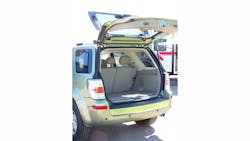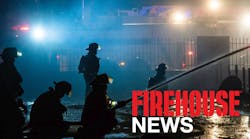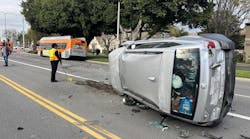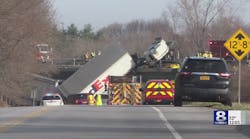SUBJECT: Liftgate/Hatchback
TOPIC: Liftgate/Hatchback Forcible Entry Safety
OBJECTIVE: Develop safety procedures when working with a jammed liftgate or hatchback
TASK: The rescue team shall identify safety concerns and describe appropriate safety procedures during rear liftgate or hatchback vehicle rescue tasks
More and more, rescuers are encountering vehicles equipped with pressurized struts under the hood and at the rear liftgate or hatchback. These cylinders serve to lift and hold the hood, hatchback, liftgate, or rear window glass in the “up” position. This University of Extrication article focuses on the inherent safety concerns they may present at a vehicle extrication scene. Although these struts have violently failed under fire situations and firefighters have been seriously injured by them, this discussion is limited to lifting strut safety concerns for responders during vehicle rescue incidents.
Strut Design
Lift support struts are a multi-piece, pressurized cylinder unit. The largest component is the cylinder chamber itself. One end of this chamber is mounted directly to the vehicle in some fashion. Inside this cylinder-shaped portion of the strut is a small volume of nitrogen, an inert gas. Because the gas has to be pressurized in order for the strut to function, internal pressures may be in the 2000-3000psi range to give the strut the power that it needs to lift and hold a large or heavy vehicle item open. For example, one gas strut manufacturer, AVM Industries, LLC, manufactures struts pressurized to over 200 atmospheres, which is almost 3,000psi. There are no pressure relief valves or blow-off relief devices built into any of these lifters.
A quantity of mineral oil is also present inside the pressurized cylinder of the lifter. This oil, along with the pressurized nitrogen gas, allows the strut to open or close in a controlled manner.
The second major component of the lifter strut is the solid piece rod that acts like a piston moving inside the cylinder as the strut opens and closes. This rod is actually the only unpressurized component of the strut. This chromed metal rod, which may be made of a hardened steel, has a gasket and seal on its inside end that allows the nitrogen gas and internal mineral oil to move smoothly inside the pressure cylinder as the strut opens and closes. The solid rod will have its outer end attached to the vehicle.
How each end of the lifter strut is attached to the vehicle is important for rescue personnel to be aware of. Responders may find an actual bolt that secures the strut to the vehicle or they may encounter a ball-type, clip-on fastener.
Rescuer safety concerns arise when confronted with a vehicle that has lifter struts on its rear hatchback, liftgate, or rear window glass. Several rescue tasks can be affected by the presence of these struts. Forcing a liftgate or hatchback open, for example, as well as total roof removal assignments are tasks where the presence of these struts must be taken into consideration.
Rear Window Glass Removal
When assigned to rear window glass removal and the vehicle has a liftgate, check to see if lifter struts are actually attached to the window glass itself before you break it. If large, round buttons are apparent on the rear window glass, this may indicate that the rear window glass has its own pair of lifter struts. When breaking this rear glass, anticipate that these struts will expand downward and outward as the glass is broken.
Forcible Opening of Liftgate or Hatchback
When assigned to forcible opening of a jammed liftgate or hatchback, assume that pressurized lifter struts exist along the inside of each rearmost roof pillar. When forcing the liftgate or hatchback open, avoid crushing the struts as this may cause the cylinder to rupture.
Strut Removal
If a liftgate or hatchback has already been opened and rescuers are assigned to take the liftgate or hatchback completely off the vehicle, the struts will also have to be dealt with. Begin by determining the type of fastening device present at each end of the strut. If one end appears to have a ball-type design, this end can easily be removed. These ball socket ends typically have a clip that can be pried up with a flat-bladed screwdriver to allow the strut to be easily pulled off the socket fitting. Quicker than that, a Halligan-type forcible entry bar can easily pop the ball socket end free with little effort.
Strut Cutting
If assigned to cut a strut for some reason, rescuers MUST realize that the only portion that should ever be cut is the chromed piston rod. Do not cut into the larger, pressurized chamber. When the strut is closed, with the piston rod retracted inside the cylinder, the strut is at its maximum pressure. What is critical to understand however is that the cylinder portion of the strut remains pressurized even when the strut is fully open and expanded. Cutting the cylinder is still a NO-NO regardless of whether the strut is open or closed. Initially work to get the liftgate or hatchback open so that the struts extend to their full length. This exposes the piston rod. Power cutters, bolt cutters, even a reciprocating saw can cut through this solid rod if it must be cut.
TASK: The rescue team shall identify safety concerns and identify hazards during rear liftgate or hatchback forcible entry






